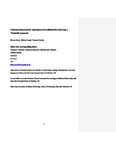Understanding students’ experiences of professionalism learning: a ‘threshold’ approach
| dc.contributor.author | Neve, Hilary | |
| dc.contributor.author | Lloyd, Helen | |
| dc.contributor.author | Collett, Tracey | |
| dc.date.accessioned | 2016-10-28T10:25:09Z | |
| dc.date.available | 2016-10-28T10:25:09Z | |
| dc.date.issued | 2016-08-22 | |
| dc.identifier.issn | 1356-2517 | |
| dc.identifier.issn | 1470-1294 | |
| dc.identifier.uri | http://hdl.handle.net/10026.1/6661 | |
| dc.description | peerreview_statement: The publishing and review policy for this title is described in its Aims & Scope. aims_and_scope_url: http://www.tandfonline.com/action/journalInformation?show=aimsScope&journalCode=cthe20 | |
| dc.description.abstract |
Professionalism is a core element of curricula in many disciplines but can be difficult to teach and learn. This study used audio-diary methodology to identify professionalism threshold concepts in a small group learning setting in undergraduate medicine and to understand factors that might facilitate students to ‘get’ such concepts. Fifteen students and seven tutors kept audio-diaries over two terms. Data were analysed qualitatively for content. The key themes were then cross referenced to threshold concept criteria (e.g. where language indicated that learning was troublesome, integrative or transformative). Seven potential threshold concepts were identified which centred on students’ developing professional identities including working with uncertainty, considering the bigger picture, not needing to know everything and professional culture. Reflection on workplace experiences within a small group helped students ‘get’ these concepts. The study concludes that threshold concepts and audio-diaries are useful tools for understanding lived experiences of professionalism learning. | |
| dc.format.extent | 1-17 | |
| dc.language | en | |
| dc.language.iso | en | |
| dc.publisher | Taylor & Francis (Routledge) | |
| dc.subject | Threshold concepts | |
| dc.subject | professionalism learning | |
| dc.subject | professional identity | |
| dc.subject | small group learning | |
| dc.subject | audio-diaries | |
| dc.title | Understanding students’ experiences of professionalism learning: a ‘threshold’ approach | |
| dc.type | journal-article | |
| dc.type | Article | |
| plymouth.author-url | https://www.webofscience.com/api/gateway?GWVersion=2&SrcApp=PARTNER_APP&SrcAuth=LinksAMR&KeyUT=WOS:000388018700007&DestLinkType=FullRecord&DestApp=ALL_WOS&UsrCustomerID=11bb513d99f797142bcfeffcc58ea008 | |
| plymouth.issue | 1 | |
| plymouth.volume | 22 | |
| plymouth.publication-status | Published | |
| plymouth.journal | Teaching in Higher Education | |
| dc.identifier.doi | 10.1080/13562517.2016.1221810 | |
| plymouth.organisational-group | /Plymouth | |
| plymouth.organisational-group | /Plymouth/Faculty of Health | |
| plymouth.organisational-group | /Plymouth/Faculty of Health/Peninsula Medical School | |
| plymouth.organisational-group | /Plymouth/Users by role | |
| plymouth.organisational-group | /Plymouth/Users by role/Academics | |
| dcterms.dateAccepted | 2016-07-26 | |
| dc.identifier.eissn | 1470-1294 | |
| dc.rights.embargoperiod | Not known | |
| rioxxterms.versionofrecord | 10.1080/13562517.2016.1221810 | |
| rioxxterms.licenseref.uri | http://www.rioxx.net/licenses/all-rights-reserved | |
| rioxxterms.licenseref.startdate | 2016-08-22 | |
| rioxxterms.type | Journal Article/Review |


